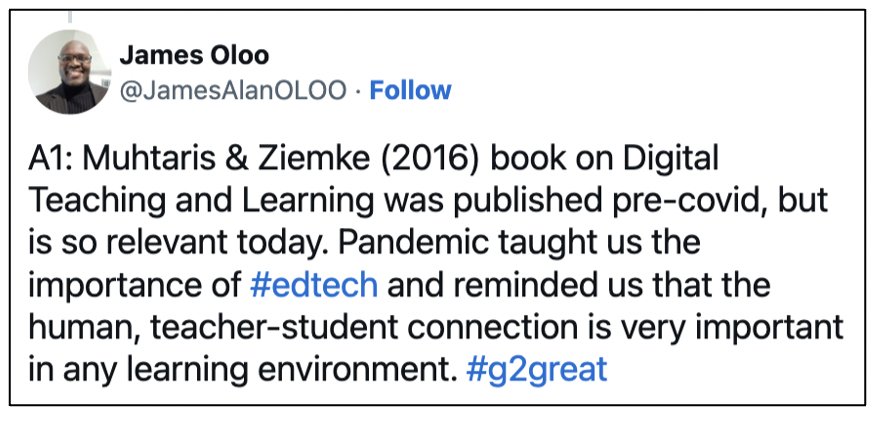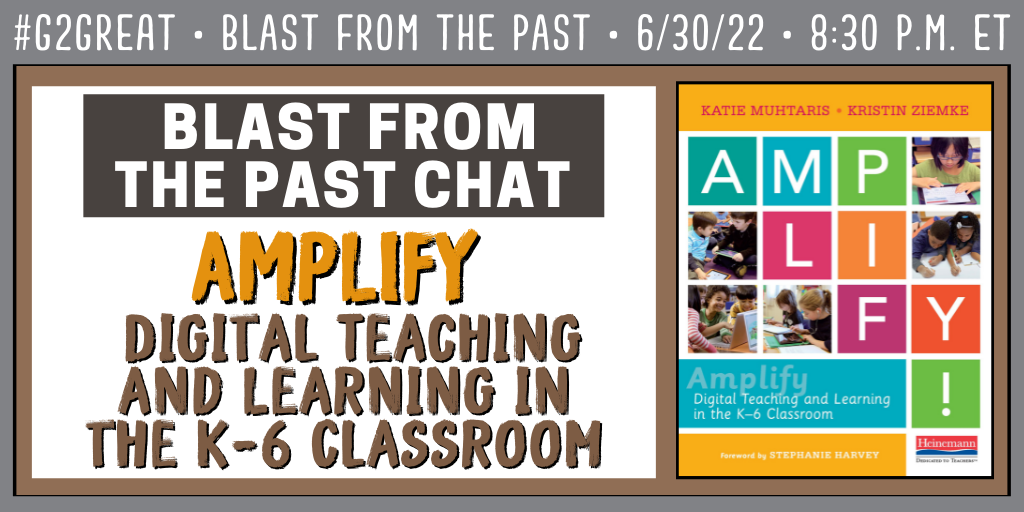
by Mary Howard
On 6/30/22, #G2Great engaged in a BLAST FROM THE PAST CHAT where we look back across our six plus year history so that we can revisit a previous chat with fresh eyes. Technology has played an increasingly prevalent educational role in recent years, so we chose a book with that in mind that we had initially spotlighted on 9/15/16; AMPLIFY: Digital Teaching and Learning in the K-8 Classroom by Katie Muhtaris and Kristin Ziemke (2015, Heinemann).
Early in the chat, James Oloo made an observation about AMPLIFY and why it is still an important professional resource even seven years after publication.
While advances in technology have supported our instructional endeavors across the years, we have seen mixed technology results ranging along a spectrum of good, bad and ugly. As Katie and Kristin eloquently remind us in a book that highlights the very best of the “good” in that spectrum, technology should be designed to AMPLIFY what we are already doing in a way that is student-centered and will enhance and support our efforts. On the other hand, we have also seen a dramatic influx of products that turn technology into one-size-fits-all scripts that tether our children to a computer screen and usurp precious minutes that could be spent in far better ways. When marketing ploys for financial gain take priority over the needs of children and our responsibility to meet those needs in meaningful relevant ways, technology has taken a dark turn that is disconcerting. If you have ever wondered which end of the good, bad and ugly spectrum your school or you as a professional falls, please read this wonderful book. You will see technology possibilities along with pitfalls to avoid as you distinguish technology designed to AMPLIFY vs. to CONSTRICT.
Katie and Kristin make this important point in a quote we shared in our chat:
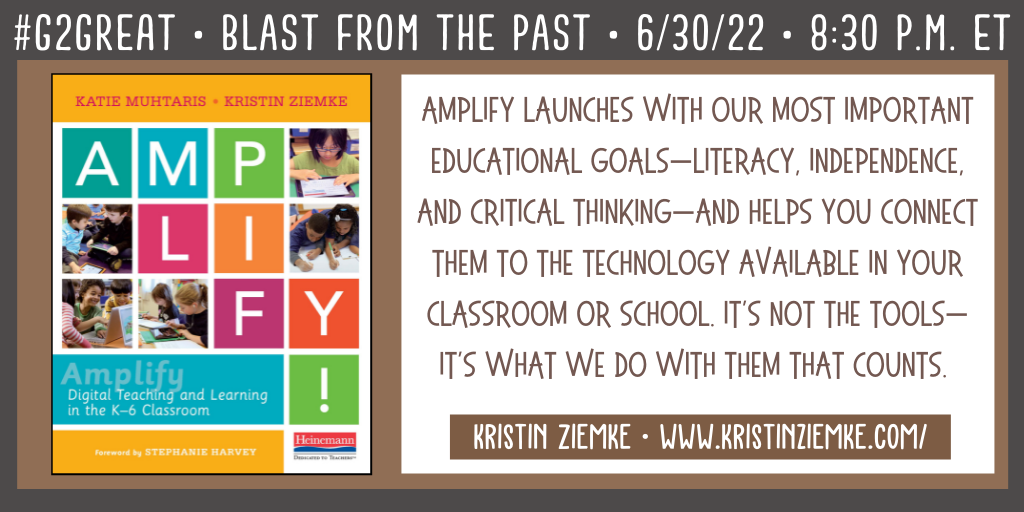
Their words should become a centerpiece that will guide our choices about the WHAT, WHEN, HOW and WHY of technology. Our educational goals of literacy, independence and critical thinking remain the same whether we use technology or not. If we relinquish these things, technology is not designed to AMPLIFY but to divert our attention away from what matters most. There is no end to the tools that are available to us, but this does not mean that all tools or the way that we view and use them are worthy of children. In other words, technology does not alter our central goals, underlying purpose and deepest innermost beliefs but rather brings those central goals, underlying purpose and deepest innermost beliefs to life in ways that honor the many instructional choices we make in a day whether technology is part of those choices or not. In my mind, this has been the tipping point for technology that is used in responsible and responsive ways and technology that dishonors the day-to-day instruction that occurs in our schools in the name of students.
These tweets from Judy Wallis and Jen&Hannah highlight this point:


Katie and Kristin further elaborate that day-to-day instruction in the name of students in their book, emphasizing that technology can be used to AMPLIFY the strategies that we are already using when technology is not used. There is an invisible thread that connects those strategies in either case.
“Using technology doesn’t mean that we throw out those strategies that we’ve found to be successful with students.”
This distinction was apparent during the Covid-19 pandemic as technology took a center stage presence in our teaching by necessity. For the first time in our history, online teaching was our only option as teachers everywhere had to pivot in an instant. Since many schools did not offer the support that teachers needed to learn and apply available tools, we began to see a range of technology support through free webinars, podcasts, sessions and a variety of books from respected authors in addition to Amplify: Read the World: Rethinking Literacy for Empathy and Action in a Digital Age by Kristin Ziemke and Katie Muhtaris (Heinemann, 2019), Connecting with Students Online: Strategies for Remote Teaching & Learningby Jennifer Serravallo (Heinemann 2020), and The Distance Learning Playbook: Teaching for Engagement and Impact in Any Setting by Doug Fisher and Nancy Frey (Corwin, 2020). Each of these books had the same message that technology is a tool that should be used to empower (or amplify) rather than diminish our teaching.
Technology can and should draw from the strategies and practices that we are already using. It’s not an either/or proposition of using technology or using the strategies when technology is not in use but using technology to merge and celebrate those same strategies and practices in meaningful ways.
We certainly learned this lesson during the COVID-19 pandemic and the necessity to pivot at a moments notice to technology-based teaching. Teachers quickly began to recognize that technology used in thoughtful ways did not require us to abandon what we held dear but did require us to highlight what was most essential in our face-to-face teaching and apply that to technology and the existing available tools that were plentiful. For many teachers, this was an important part of the learning curve, even in the midst of chaos. In many ways, it was a wakeup call to maintain our sights on research-based knowledge that guides our professional decision-making with or without technology.
Judy Wallis and Fran McVeigh share important points:

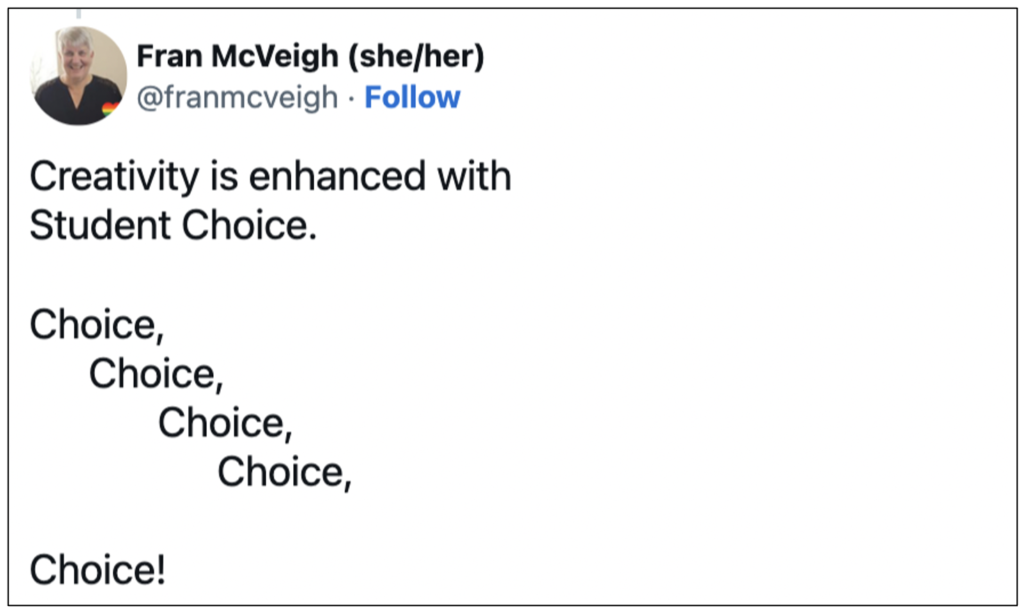
I’d like to end with this student-centered reminder from kindergarten teacher Mollie Nye. Regardless of the choices we make when it comes to technology, our children are the overarching guide for making those decisions based on their needs at that time. This is not about using technology for the sake of using technology but rather keeping our commitment to always remain steadfast in our belief that we have a responsibility to be responsive to students to the needs of students and keep tat at the center of all we do.
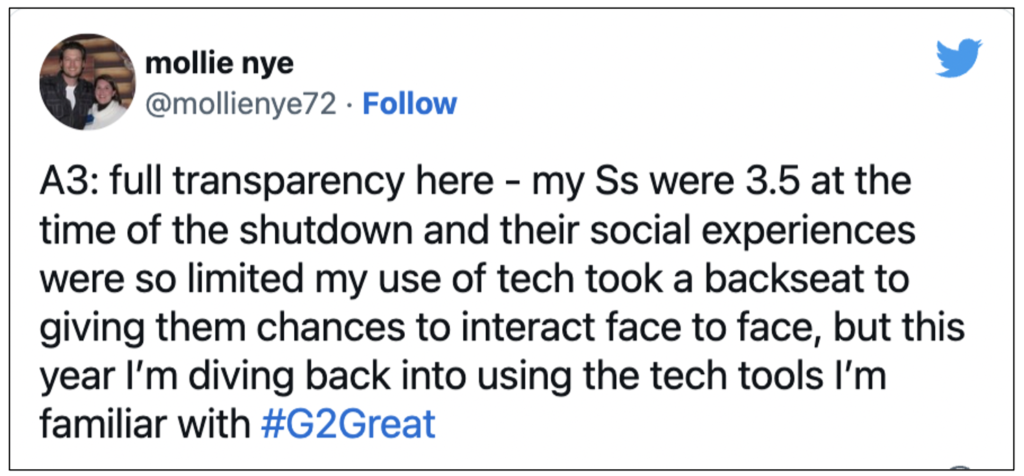
I’d like to reiterate Jame’s Oloo’s tweet I shared at the beginning of this post that AMPLIFY continues to be relevant still today. We are very grateful to Katie Muhtaris and Kristin Ziemke for inspiring us yet again with a second look at AMPLIFY.
LINKS
AMPLIFY: Digital Teaching and Learning in the K-8 Classroom by Katie Muhtaris and Kristin Ziemke (2015, Heinemann).
Read the World: Rethinking Literacy for Empathy and Action in a Digital Age by Kristin Ziemke and Katie Muhtaris (Heinemann)
A Guide for Amplify AND Read the World by Kristin Ziemke and Katie Muhtaris (Heinemann)
Kristin Ziemke and Katie Muhtaris Website: Read the World + Amplify
